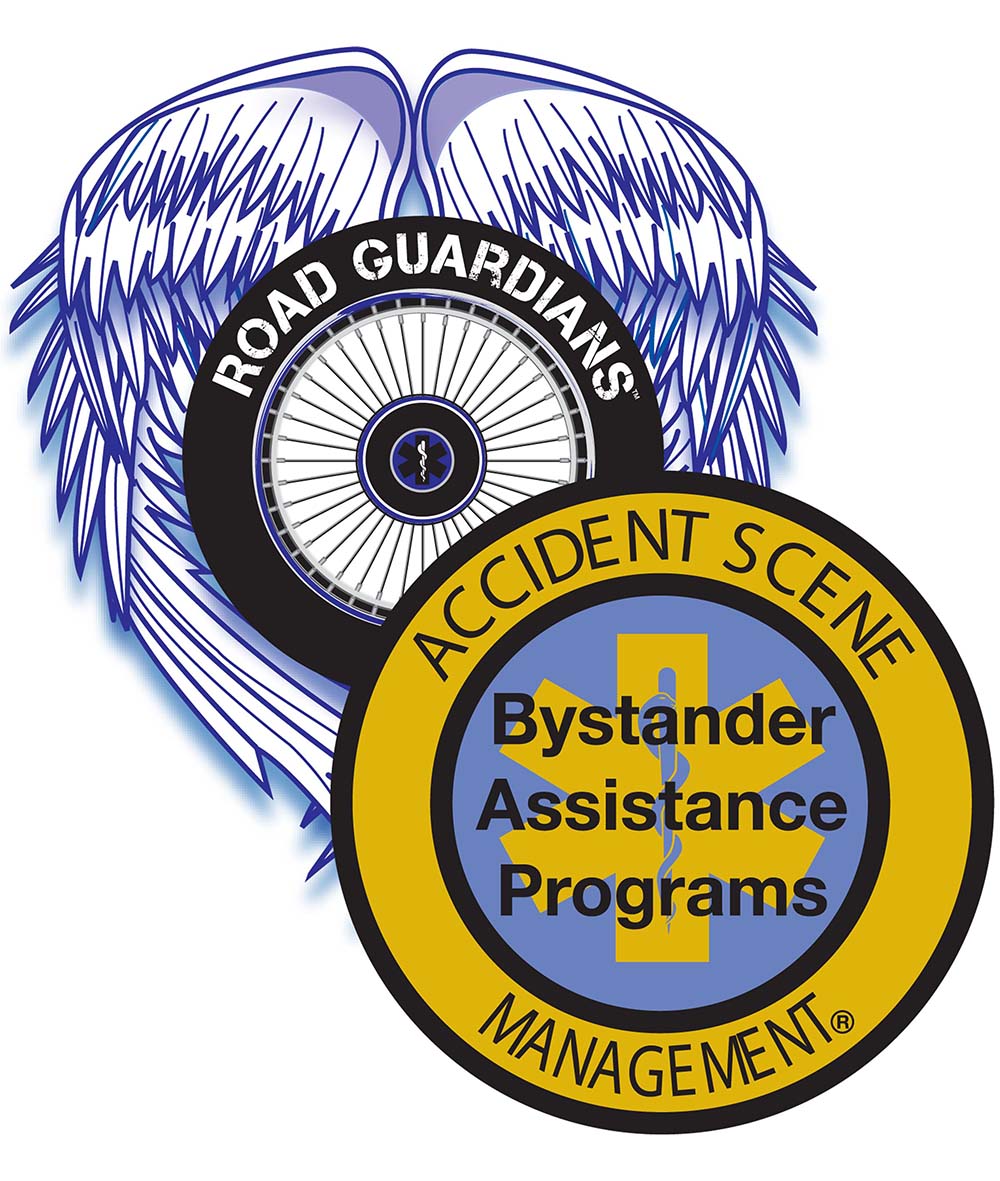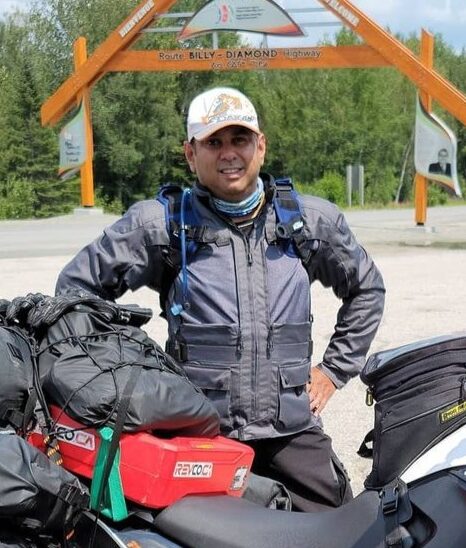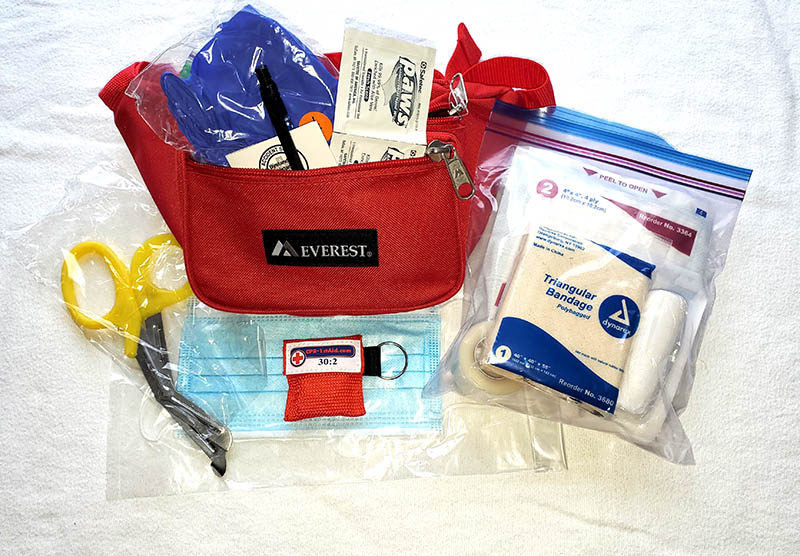
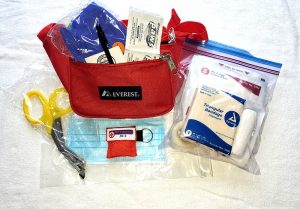 Many of us who have been riding any length of time know that it is a good idea to carry some basic first aid items. Items such as Ibuprofen, band-aids, sting relief, burn cream, and antiseptic wipes are a part of most first aid kits and can come in handy for everyday situations. Often a motorcyclist who has considered a First Aid kit will purchase a commercial kit in an attempt to have something available. Too often those kits are full of unneeded items. Have you ever taken a look at the contents of a general first aid kit? The label proudly proclaims “120 items! Upon closer inspection, however, you will find that many of the times will not be useful, especially if you need something bandaging for a more serious injury than pinching your finger or getting a bug bite. As an RN, an Iron Butt rider, and the author of “A Crash Course for the Motorcyclist”, I have given a great deal of thought regarding what the most important things are that a motorcyclist should carry.
Many of us who have been riding any length of time know that it is a good idea to carry some basic first aid items. Items such as Ibuprofen, band-aids, sting relief, burn cream, and antiseptic wipes are a part of most first aid kits and can come in handy for everyday situations. Often a motorcyclist who has considered a First Aid kit will purchase a commercial kit in an attempt to have something available. Too often those kits are full of unneeded items. Have you ever taken a look at the contents of a general first aid kit? The label proudly proclaims “120 items! Upon closer inspection, however, you will find that many of the times will not be useful, especially if you need something bandaging for a more serious injury than pinching your finger or getting a bug bite. As an RN, an Iron Butt rider, and the author of “A Crash Course for the Motorcyclist”, I have given a great deal of thought regarding what the most important things are that a motorcyclist should carry.
Due to limited space, the items a motorcyclist carries should be chosen with great care. You should consider the items you carry to be similar to tools. If your bike breaks down you will want to have some basic tools with you in order to repair simple things. A first aid kit of any kind for a motorcyclist should contain basic trauma-related supplies in the event you need to render assistance in an emergency. Once you have these “essential” trauma supplies then you can add other items for comfort and basic first aid. You should start by making sure that your kits include the following items:
- Nitrile gloves (2 pair minimum)
- Face Mask – 3 ply
- Antiseptic Hand wipes (or hand sanitizer)
- Trauma sheers (7.5-inch paramedic sheers)
- Rescue breathing barrier
- Triangular Bandage (40×40 inch)
- 4×4 Sterile Gauze
- 3 inch Roll gauze
- 1-inch tape
- Pen and Paper
In order to determine how much to carry you will want to answer two important questions:
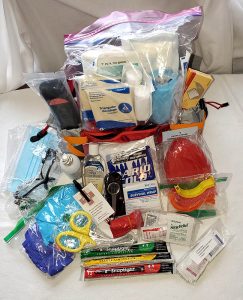
I will address space issues first. It’s best to choose a pack that is soft-sided to make it easiest to pack and because it is space-saving. After all, you might need that space for other important items. It is a bonus if the pack you choose is water-resistant (PVC lined). For many years I kept my water-resistant pack on the outside of my bike, bungeed to the rear fender so that it would be easily accessed and never get buried in the saddlebag. It also saved space in my saddlebags. I now keep my trauma kit in my tour pack. If you choose to keep your supplies in a side bag you will want to keep them in the right-side saddlebag. This will prevent you from having your back to traffic while retrieving the bag. Your kit should always be the last thing you pack so that it does not get buried. You should consider a bag that is a color other than black so it doesn’t get lost with all the other black bags and is easier to identify in an emergency. Some groups recommend using a reflective red cross on the saddlebag so people know where you keep your supplies.
What can you afford?
That is a question only you can answer. I’ve never had someone come back to me saying they carried too many supplies with them but I have had people come to me saying they wished they had more supplies. If you have extra space and can afford it, there are more items that you will be glad you have with you in the event you need them such as eyewash, lighting, emergency blanket, alcohol-based handwash, and an ice pack. Of course, the first aid items listed earlier in this article are helpful along with electrolytes, antibiotic ointment, and a quick guide to first aid. If you have more than one bike I would recommend carrying a kit on each bike using the same guide of carrying as much as you reasonably can. I’ve found that having one kit for several vehicles just lends itself to forgetting the trauma pack when you need it most.
One last recommendation is to check your supplies monthly to be sure that heat and moisture have not ruined anything. When we build motorcycle trauma packs, we seal anything that could be ruined by water in a Ziplock style re-sealable bags. Some supplies such as eye-wash and medications will have expiration dates on them. Chemical Cold/Hot packs can activate from the pressure and vibration of being in your saddle gas so they should be checked. Monthly inspections will also help you get familiar with your supplies and where they are located in your pack.
If you are interested in a list of supplies recommended for four levels of trauma packs, CLICK HERE. If you want a list of different sized recommendations in written form, an SOS brochure can be downloaded and printed to show the contents. Keep in mind that all recommendations
Of course, knowing what to do with your supplies can be an issue as well so you should consider Accident Scene Management, First Aid, and CPR training as well as supplies. To get proper first response training contact the leading motorcycle trauma training organization in the world, Accident Scene Management (ASM). To find classes or certified instructors in your area click on www.roadguardians.org. Are you ready to help a friend in need? Are they ready to help you!
Vicki Sanfelipo, RN
Executive Director ASM/Road Guardians
Sturgis Motorcycle Hall of Fame 2020
